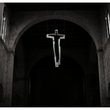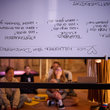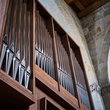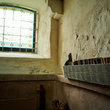Crypt- commemoration of the dead then and now.
No one wants to be forgotten after death.
Not even a king.
Henry the First wants to be buried in Quedlinburg.
Why? Nobody knows.
Henry the First was the first German king.
He died over a thousand years ago.
His tomb is in the crypt.
The crypt is a cellar∙room under the altar.
Commemorating the dead at that time.
King Henry the First determined:
The crypt is a place
- to pray and to sing.
- for reminiscences.
- for meetings of the royal family.
The tomb in the crypt
is a symbol of the royal family.
A symbol of power and dominion.
After the death of Henry the First.
The royal family establishes a nunnery.
A convent is almost like a monastery.
In the convent, the dead are to be remembered.
The convent was very rich.
The Stifts∙kirche was given many precious things.
These things are in the cathedral treasury today.
The abbess is in charge of the monastery.
The crypt
In the crypt are buried:
- Henry the First
- Henry the First's wife.
Her name is Saint Matilda.
- And the first abbess.
Her name is also Mathilde.
After that, all the abbesses were given
were given special burial plates.
You can see the picture of the abbesses
on the walls.
It's made of stone.
That's special.
Because only the royal family was given
were given tombstones like this.
The ceiling of the crypt is painted.
There you can see stories from the Bible.
Remembering the dead today
We remember the deceased of our family.
For example, in the cemetery.
In the collegiate church we remember...
we remember the royal couple, Henry and Matilda.
On the day of their death, we have a service.
This has a long tradition.






